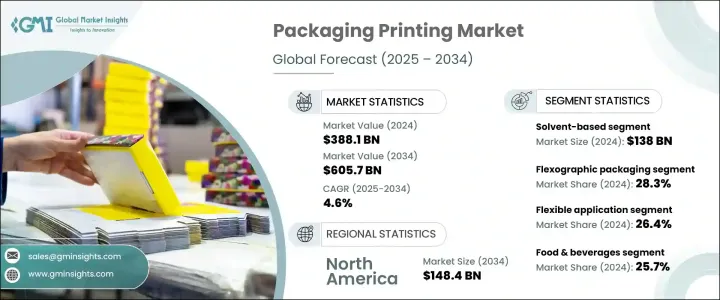
세계의 포장 인쇄 시장은 2024년 3,881억 달러에 이르렀으며, 2025년부터 2034년까지 연평균 복합 성장률(CAGR) 4.6%로 확대될 것으로 예측됩니다.
이 성장은 주로 고품질이며 시각에 호소하는 패키징 솔루션이 요구되는 전자상거래 산업의 활황에 힘쓰고 있습니다.

이 분야의 기업은 진화하는 업계 표준에 대응하기 위해 고해상도로 지속가능한 인쇄방법에 주력하고 있습니다. 브랜드가 혁신적인 패키징 솔루션에 투자하는 동안, 시장 관계자는 지속 가능한 관행을 활용할 수 있는 큰 기회를 얻고 있으며, 장기적인 성장을 확실히 하고 있습니다.
| 시장 범위 | |
|---|---|
| 시작 연도 | 2024년 |
| 예측 연도 | 2025-2034년 |
| 시작 금액 | 3,881억 달러 |
| 예측 금액 | 6,057억 달러 |
| CAGR | 4.6% |
시장은 인쇄 잉크의 유형에 따라 구분되며, 솔벤트계, UV계, 수성, 기타가 있습니다. 솔벤트계 잉크는 비다공성 기재에 대한 강력한 접착성으로, 2024년 시장 규모 1,380억 달러로 업계를 지배하고 있습니다. 기업은 고품질 인쇄에 대한 수요 증가에 대응하기 위해 개선 된 솔벤트 기반 솔루션을 계속 개발하고 있습니다. 사용되는 인쇄 기술로는 그라비아 인쇄, 플렉소 인쇄, 디지털 인쇄, 오프셋 인쇄, 하이브리드 인쇄 등이 있습니다. 플렉소 인쇄는 2024년에 28.3%의 수익 점유율을 차지해, 식품이나 의약품을 포함한 다양한 포장 용도로 고해상도의 인쇄를 실현하는 능력이 그 원동력이 되고 있습니다.
용도별로는 골판지, 플렉서블, 종이기, 라벨 태그 등이 있습니다. 5.7%로 확대될 것으로 보이며, 재활용률이 높아 기업에 골판지 소재의 채용을 촉구하고, 이 부문에 있어서의 인쇄 솔루션 수요를 한층 더 높이고 있습니다. 이 제품은 2024년 시장 점유율의 25.7%를 차지했으며 브랜드는 엄격한 라벨 규제를 준수하기 위해 지속 가능한 인쇄 방법을 선호합니다.
지역별로는 북미 포장 인쇄 시장이 기술의 진보와 효율적인 인쇄 솔루션에 대한 수요가 높아짐에 따라 2034년까지 1,484억 달러에 이를 것으로 예측되고 있습니다.
The Global Packaging Printing Market reached USD 388.1 billion in 2024 and is projected to expand at a CAGR of 4.6% from 2025 to 2034. This growth is primarily fueled by the booming e-commerce industry, which demands high-quality, visually appealing packaging solutions. The increasing preference for online shopping has intensified the need for advanced printing techniques that enhance packaging aesthetics while maintaining essential product information.

Companies in this sector are focusing on high-resolution, sustainable printing methods to meet evolving industry standards. With sustainability becoming a core priority, businesses are adopting eco-friendly printing inks with lower VOC emissions. Additionally, the rise of short-run and on-demand digital printing is adding value, offering flexibility and faster turnarounds. As brands invest in innovative packaging solutions, market players have significant opportunities to leverage sustainable practices, ensuring long-term growth. The demand for packaging printing spans various applications, necessitating high-performance printing techniques across multiple packaging materials.
| Market Scope | |
|---|---|
| Start Year | 2024 |
| Forecast Year | 2025-2034 |
| Start Value | $388.1 Billion |
| Forecast Value | $605.7 Billion |
| CAGR | 4.6% |
The market is segmented based on printing ink type, including solvent-based, UV-based, aqueous, and others. Solvent-based inks dominated the industry with a market value of USD 138 billion in 2024, owing to their strong adhesion to non-porous substrates. Companies continue to develop improved solvent-based solutions to meet the growing demand for durable, high-quality printing. Printing technologies used in the industry include rotogravure/gravure, flexographic, digital printing, offset printing, and hybrid printing. The need for large-volume, short-run, and high-quality prints is driving advancements in these technologies. Flexographic printing held a revenue share of 28.3% in 2024, driven by its ability to deliver high-resolution prints across diverse packaging applications, including food and pharmaceuticals.
By application, the market includes corrugated, flexible, folding cartons, labels & tags, and others. The corrugated packaging segment is set to expand at a CAGR of 5.7% up to 2034, driven by the increasing global shift toward sustainability. Strong recycling rates are encouraging companies to adopt corrugated materials, further increasing the demand for printing solutions in this segment. The market is also categorized based on end-use industries, such as personal care & cosmetics, food & beverages, chemicals, household products, electronics, pharmaceuticals, and others. Packaging printing plays a crucial role in meeting regulatory requirements, especially in the food & beverage sector. This industry accounted for 25.7% of the market share in 2024, with brands prioritizing sustainable printing methods to comply with strict labeling regulations.
Geographically, the packaging printing market in North America is projected to reach USD 148.4 billion by 2034, driven by technological advancements and increasing demand for efficient printing solutions. The US market alone was valued at USD 73.4 billion in 2024, with digital printing technology gaining traction as companies shift toward short-run, on-demand printing solutions.